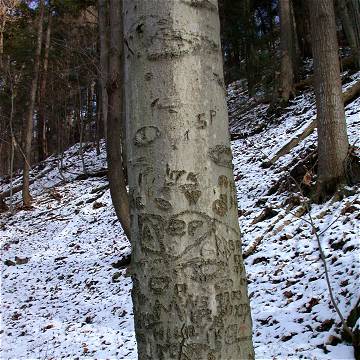

Fagus grandifolia - (image 1 of 8)
Taxonomy
Family: Fagaceae
Habitat
Moist, well-drained slopes and rich bottomlands. Does not do well in compacted soils and prefers the pH on the acid side. Shade-tolerant.
Associates
In climax forest often found with Acer saccharum, Betula alleghaniensis, Carpinus caroliniana, Fraxinus americana, Hamamelis virginiana, Mitchella reptens, Tsuga canadensis, Ulmus americana, Viburnum acerifolium. Epifagus virginiana (beechdrops) is a small parasitic plant of Beech.
Distribution
From WI southwest to TX and east to the Atlantic.
Morphology
Medium tree with a broad crown. Open grown specimens tend to branch to the ground. Leaves alternate, simple, ovate, acuminate, veins straight and parallel each ending in a tooth. Beech buds are very long and pointed. Flowers monoecious. Fruits 3-sided nuts in a bristly red-brown husk with 4 parts, ripening in fall.
Notes
Flowers late April to late May
Wetland indicator: Facultative Upland
The smooth, pale gray bark is frequently the target of graffiti. Fall color is difficult to appreciate until you see it in the wild, with shades of red-brown that seem to glow when sunlight filters through it. Nuts are edible and an important food source for wildlife. Young trees often hold their leaves through the winter. Oaks, which are in the same family, often do this when young as well. The last image shows a very young beech tree next to the flowers of beechdrops.
Bibliography
Farrar, J. L. 1995. Trees of the Northern United States and Canada.
Ames, Iowa: Iowa State University Press
Swink, F. and G. Wilhelm. 1994. Plants of the Chicago Region.
Indiana Academy of Science. The Morton Arboretum. Lisle, Illinois.
|
Michael Hough © 2004 |